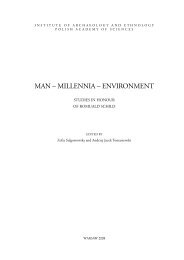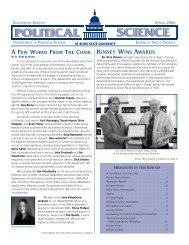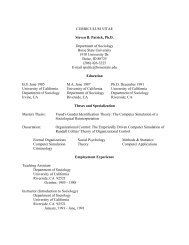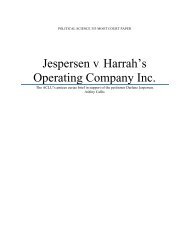From Incivility to Outrage - College of Social Sciences & Public ...
From Incivility to Outrage - College of Social Sciences & Public ...
From Incivility to Outrage - College of Social Sciences & Public ...
You also want an ePaper? Increase the reach of your titles
YUMPU automatically turns print PDFs into web optimized ePapers that Google loves.
Downloaded by [Boise State University] at 17:30 21 December 2011<br />
Political Discourse in Blogs, Talk Radio, and Cable News 37<br />
opinionated citizens immersing themselves in a media world filled with voices who share<br />
and bolster their existing perspectives without challenging them. 12<br />
We recognize that this research raises as many questions as it answers and hope that<br />
this preliminary roadmap proves useful as a baseline for future comparisons, as we can<br />
begin <strong>to</strong> gather data about changes in political speech over time. It is our hope that other<br />
researchers will join us in exploring these issues further.<br />
Notes<br />
1. Jamieson and Cappella (2008) <strong>of</strong>fer a noteworthy exception.<br />
2. Indeed, many <strong>of</strong> the greatest political changes in the United States have been preceded by<br />
emotional appeals highlighting the plight <strong>of</strong> various constituencies (e.g., the civil rights movement).<br />
3. There is a long his<strong>to</strong>ry <strong>of</strong> research on the impact <strong>of</strong> negativity in politics, particularly negative<br />
campaign advertising, in which negative information is relatively undifferentiated and messages<br />
are coded as broadly positive or negative (the benchmark research is Ansolabehere & Iyengar, 1995),<br />
but critics have suggested that without more information about types <strong>of</strong> negativity, the findings <strong>of</strong><br />
negativity effects research are difficult <strong>to</strong> interpret. Much recent research, therefore, examines negativity<br />
with more nuance, differentiating between such characteristics as negative information about<br />
issues versus negative information about people and civil versus uncivil modes <strong>of</strong> delivery. See the<br />
citations on incivility above as well as Brooks (2006) and Sigelman and Park (2007) for critiques <strong>of</strong><br />
the negativity research.<br />
4. These numbers are from Nielsen, as reported by Fox News Channel in an advertisement in<br />
the Wall Street Journal (July 16, 2009).<br />
5. Project for Excellence in Journalism State <strong>of</strong> the News Media 2010, citing Inside Arbitron<br />
and other sources.<br />
6. Talkers Magazine, “Top Talk Personalities,” Spring 2009 (cited in State <strong>of</strong> the News Media<br />
2010, “Talk Radio” 2010).<br />
7. Sampling posts from some blogs, such as the Huffing<strong>to</strong>n Post, which have more complex<br />
structures and many nested blogs, required additional instructions that are available from the authors<br />
but <strong>to</strong>o detailed <strong>to</strong> enumerate here.<br />
8. Coders assessed overall <strong>to</strong>ne subjectively, in conjunction with extended definitions <strong>of</strong> both<br />
outrage speech and conventional political speech (available in the codebook upon request). The coding<br />
instructions read: This variable asks your assessment <strong>of</strong> the overall <strong>to</strong>ne <strong>of</strong> the program, column,<br />
blog, etc. This particular variable is about the intensity <strong>of</strong> the outrage. The variable OAMOUNT<br />
should be used <strong>to</strong> assess the amount <strong>of</strong> outrage. The coders were asked <strong>to</strong> consider the following:<br />
Taken as a whole, describe the case you have just analyzed: (00) overall <strong>to</strong>ne is more aptly described<br />
as conventional political speech (content and form OVERALL are more aptly described as “conventional”<br />
political speech, even if there are moments that technically count as outrage), (01) light<br />
intensity outrage (close <strong>to</strong> the border <strong>of</strong> “conventional” political speech), (02) moderate intensity<br />
outrage (outrage is present, but not overly emotional in form and/or content), (03) intense outrage<br />
(there are windows <strong>of</strong> reason, but the content and/or form is generally quite emotional), and (04) very<br />
intense outrage (content and/or form may match but infrequently exceed this level <strong>of</strong> emotionality).<br />
9. Using an unpaired, unequal variance t test, we can reject at the .001 significance level that<br />
the overall <strong>to</strong>ne mean <strong>of</strong> columns is the same as the other formats and accept that radio, TV, and<br />
blogs have a higher mean overall <strong>to</strong>ne than columns.<br />
10. Indeed, playing this edge is not without its challenges. Interpersonal conflict, when real,<br />
makes many uncomfortable and must be domesticated in order <strong>to</strong> retain viewers (Arceneaux &<br />
Johnson, 2008).<br />
11. The five leading syndicated liberal columnists for 1975 were Joseph Kraft, Mary McGrory,<br />
William Raspberry, Anthony Lewis, and Tom Wicker. The conservatives were Vermont Royster,<br />
William F. Buckley, George Will, William Safire, and Rowland Evans/Robert Novak. For 1955, we<br />
found the leading columnists <strong>to</strong> be mostly moderate in <strong>to</strong>ne. Based on their home papers and reputations,<br />
we chose the following columnists: Stewart Alsop, Joseph Alsop, Walter Lippman, Arthur







